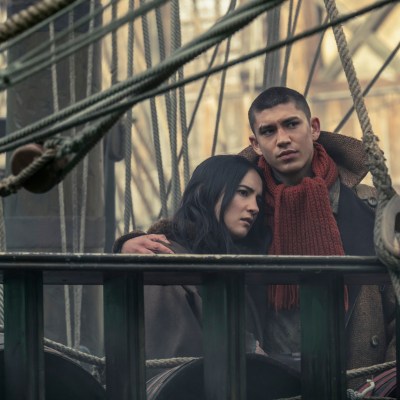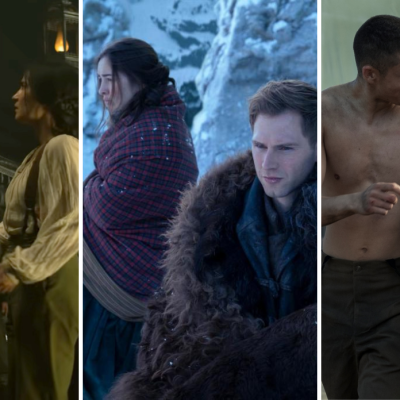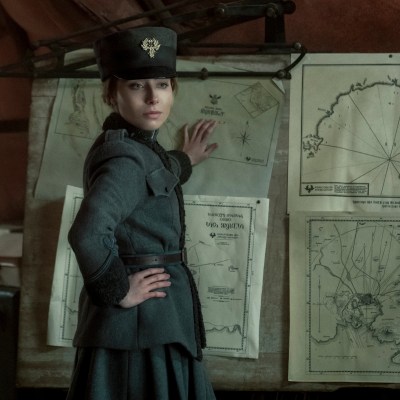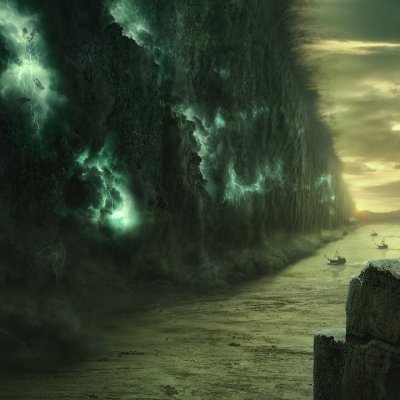Do Shadow and Bone & Six of Crows Work as One Story?
Two pop culture critics debate the pros and cons of Netflix’s decision to incorporate the characters from Six of Crows into the Shadow and Bone adaptation.
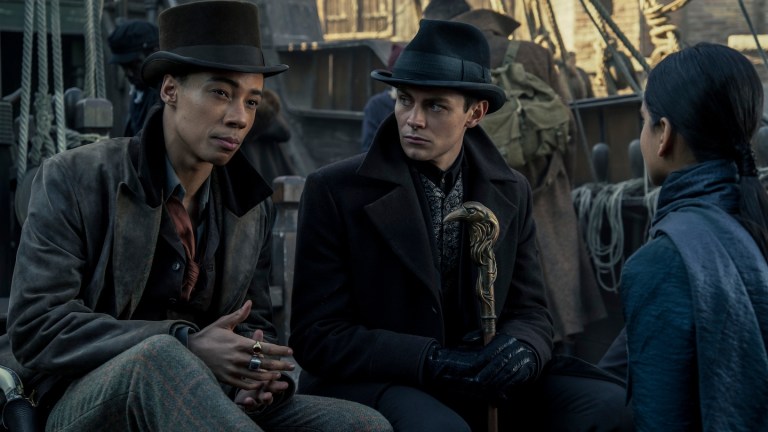
This SHADOW AND BONE feature contains spoilers for Season 1.
Though Netflix’s new fantasy series Shadow and Bone is based on the bestselling Grishaverse novels of author Leigh Bardugo, it’s not a straightforward adaptation of the book series that shares its name. In addition to the Shadow and Bone trilogy, the series also incorporates elements from Six of Crows, a duology that is set in the same world, but focused on a very different set of characters.
Set two years after the events of Shadow and Bone, Six of Crows is a dramatic heist story set in a different country (Kerch) and starring a set of characters who really don’t take part in the events of the first trilogy. Until now. Shadow and Bone attempts to create what are essentially prequel storylines for the major characters of Six of Crows: criminal mastermind Kaz Brekker, assassin Inej Ghafa, gunslinger Jesper Fahey, and spy Nina Zenik.
How these figures would fit into the series’ existing storyline of the discovery of a legendary Sun Summoner with the power to destroy the Shadow Fold was a question that every book fan was wondering prior to the series debut. And now that Shadow and Bone is here, it’s time to dig into whether this fusion of these two separate-but-related series worked or not.
Den of Geek editor Kayti Burt and Den of Geek contributor Lacy Baugher dig into the specifics of the good, the bad, and the somewhere in between when it comes to incorporating the Six of Crows characters into Shadow and Bone. Welcome to our discussion, and feel free to share your own thoughts in the comments below…
Question: Going into this series, what did you think about Netflix’s choice to integrate Six of Crows into Shadow and Bone? Did you think it would work?
Kayti: As someone who has only read the first book in the Shadow and Bone series and neither of the Six of Crows duology, I was intrigued.
As a viewer of adaptation, I tend to hold my opinions until I’ve at least seen the trailer and… well, the first teaser (which is the only trailer I watched before binging the screeners) didn’t give much away. That being said, there’s nothing that frustrates me more than an adaptation that is overly faithful to the plot without being faithful to the tone, characters, and themes of the source material, so I think I am much more tolerant of major plot changes when it comes to adaptation than the average viewer?
Lacy: I will admit that I was extremely apprehensive about it. I mean, I get the impetus to combine both sets of characters into a single story if only to allow Six of Crows fans the chance to see favorites like Kaz and Jesper onscreen. (There are no guarantees that Shadow and Bone would be successful enough to even get a second season, let alone a sequel/spin-off about a completely different cast, after all.)
But the thing is, Six of Crows is a very different story from Shadow and Bone – from setting and characters, to the time it takes place. (It’s actually set two full years after the events in the final Shadow and Bone novel, Ruin and Rising.) Furthermore, it’s also a very different kind of story. Six of Crows is very much a heist drama and one that’s not concerned so much with things like love triangles or larger Ravkan politics. And the characters are, of necessity, much darker and more morally gray than Alina and her friends. I worried that the two worlds of these stories wouldn’t mesh well, or that there simply wouldn’t be anything for the Six of Crows crew to do.
Kayti: Yeah, these are such valid concerns! Even as someone who had never read Six of Crows, I knew that these series, while set in the same world, were doing very different things.
Reading your response, Lacy, I also think I saw it as a way to incorporate the more popular Six of Crows material into the slightly less popular Shadow and Bone, which did make me a bit nervous, as it seemed to be a marketing decision more than a story one. That being said, with good storytellers, those two motivations do not have to be mutually exclusive!
Question: Now that you’ve seen the show, what do you think works with the strategy?
Lacy: Shadow and Bone does, I think, pull off the inclusion of the Six of Crows crew fairly well. Much better than I expected it to if I’m honest.
There are certainly problems – for the first four episodes, it generally feels like the Crows cast exists in an entirely different show that has very little to do with the stuff happening in Os Alta. Shadow and Bone is also generally terrible as a series at drawing any sort of distinctions about what makes life in Kerch different from that in Ravka and how that might have shaped these people.
But the character work is honestly great, and the addition of this Six of Crows prequel plot adds some really interesting layers to Inej and Jesper especially. The show is really clear that the latter obviously has Grisha power in a way that the books are not, and Kit Young steals almost every scene he’s in. (Milo the goat! I cannot! Protect him!)
I also love the way that the show fleshes out Inej, both in terms of her past and how the overhanging threat of returning to the Menagerie impacts her choices, as well as the way her religious beliefs shape who she is. (There’s something honestly wonderful about the fact that she gets to meet and know Alina, who is – and will become even more fully – revered as a saint by her faith, and I just love that for her.)
Kayti: I agree! For the first half of the season, I wasn’t sure if it worked, and I do think that has something to do with the weakness of setting in this adaptation. For parallel storylines to work well, they need to have a strong sense of world-building. In that way, even if there aren’t explicit plot or character connections between the two (or more!) storylines, then each storyline still adds something to the other(s) by virtue of telling us something about the larger world they share. Game of Thrones did this famously well, as does The Expanse. In Shadow and Bone, the articulation of setting is one of the adaptation’s weakest elements—the world and its cultures don’t truly feel real or lived in to me—and I think that hurts the integration of these two book series.
That being said, once the characters and plot collide in the second half of the season, this integration works incredibly well for me. I loved the final episode for so many reasons, but one of the big ones was for how integral the Six of Crows characters (or at least Jesper, Inej, and Kaz) felt to this climax—I mean, Inej throws a dagger into The Darkling! By the end of this season, it didn’t matter to me that the world-building didn’t quite work because I was so invested in these characters. (And I loved the Inej/Alina stuff, as well.)
And then, of course, we have Nina and Matthias off on their own, little subplot, giving me the Jon Snow/Ygritte vibes. Again, this subplot picked up steam for me. At the beginning, I didn’t know why we should care, but these actors really brought their “A” game when it came to their Enemies to Friends to (Almost) Lovers journey, complete with There Is Only One Bed and Huddling For Warmth. I never stood a chance.
Lacy: There is Only One Bed!!! Truly, the best romantic trope there is. Heart eyes emoji.
You’re really right about Shadow and Bone and how it articulates setting. On some level, the fact that the Shadow Fold is the most fully realized location in the show makes a lot of sense – it’s huge, monstrous, and terrifying. But this focus has the downside of making almost everywhere else look and seem exactly the same. (I really would like to know how many viewers didn’t/haven’t yet realized that Kerch is an entirely separate country with different laws about Grisha.)
The utter destruction of the West Ravkan city of Novokribirsk at the end of the season is supposed to be really shocking and underline how depraved the Darkling is, but I don’t think it hits as hard as it should – part of the reason is that the show has plenty of other opportunities to show us the Darkling’s flaws, but it’s also because there’s no real attempt to give West Ravka any real sense of place or identity.
Question: What do you think doesn’t work?
Kayti: I think that some of the supporting characters from Shadow and Bone get lost in the shuffle here, as does the Ravka world-building, and I think that is partially because we spend so much time with the Six of Crows gang. There’s nothing to say that, even if Six of Crows hadn’t been incorporated into this adaptation, we would have had more Os Alta or that more would have been better. In both the source material and the adaptation, the Os Alta stuff feels perfunctory rather than inspired. I would have loved to see the adaptation breathe new life into it, similar to what they did with Mal in the translation, who is a much fuller character in the Netflix series than he is in the book.
Lacy: Kaz Brekker, unfortunately. I mean, I think part of this is because there are aspects of who Kaz is and what he’s been through that you just can’t find out right now because of the story that’s still to come in Six of Crows and how that all plays into things there.
This is probably the right decision, but it has the really annoying side effect of making Kaz the least interesting character in Shadow and Bone for me. And if you’ve read the books, you know that’s the furthest thing from the truth. But here, Kaz is basically just a dude with a cool walking stick who’s kind of super into Inej for some reason and hates a man named Pekka Rollins. There’s almost no sense of who he is on his own terms or why he behaves the way he does.
Kayti: As someone who has yet to read Six of Crows, the degree of mystery around Kaz’s character worked for me. The character performance was strong enough that, even though I wanted answers about his backstory now, it felt more in a “I am getting what I need, not what I want” sort of viewing experience—though I get how this could be different if you already know and love his character.
As a non-book reader, I love the tension of not knowing what the heck is up with Kaz because it seems so in line with who he is as a character—jaded, angry, and prone to pushing people away. Of course, if he didn’t have enough sense to be friends (or whatever) with Inej and Jesper, I probably wouldn’t have as much time for his bullshit. The fact that these two seem to vouch for him as a person worth standing by goes a long way for me, and makes his character all the more intriguing.
Question: Do you foresee any problems with this strategy moving forward?
Lacy: Where do they go from here? The end of Shadow and Bone Season 1 sort of puts all the pieces in place for what feels like it’s about to become the first novel in the Six of Crows series. The Crows gang is on a boat heading back to Ketterdam, Nina is on the same ship with them, clearly about to join their crew with her own Matthias-related agenda. Alina and Mal are heading off on their own journey, which will take them on a completely different path. (Both figuratively and literally speaking.)
Is Shadow and Bone just going to move up the timeline of Six of Crows and put the rest of that story as a sort of B plot to the elements of Siege and Storm that will inevitably drive any Season 2? Season 1 successfully managed to use these characters by basically inventing a backstory for them that wasn’t present anywhere else. (Though it should be noted that Nina’s does come from the books.) I’m not sure that I think they can successfully do that again. But if they do adapt Six of Crows, how does that story fit here – especially if it means they can’t easily cross back into the main narrative?
I’m nervous, is what I’m saying. But the show has pleasantly surprised me thus far, so I live in hope.
Kayti: As someone who hasn’t read the books, I am blissfully ignorant, though, as our two main groups of characters are heading in different directions (both figuratively and literally, as you say, Lacy), I’m not sure what Season 2 is going to look like. Are these characters going to be in completely different stories? Because that doesn’t sound like the best idea. Or is the world-changing stakes of The Darkling and his pet shadows big enough that it will pull all of our main characters in?
Whatever happens in terms of the Shadow and Bone/Six of Crows division, I am very excited to see Nina and Matthias fully engage with Inej, Jesper, and Kaz. Maybe they will spend Season 2 together, with the events of the Six of Crows plot, and come back together somehow with Alina & co. for Season 3?
Lacy: You know, I actually don’t mind that idea at all – sort of letting everyone be free to do their own specific series-mandated things next season and then come back together again in Season 3. Because I think what bugs me is the idea that we might have been sort of gifted this really nifty blending of the book narratives and then have it taken away with nary a mention again. (I also just really want Nina to meet Alina, sue me.)
The more I think about it, the more I don’t necessarily see why we couldn’t have some of the Six of Crows plot here – yes, technically it takes place later on, chronologically speaking, but the show itself has already moved up the timeline of Matthias’ impending imprisonment in Hellgate, which is a big initial mission the Crows crew has to sort of undertake. I don’t think he deserves to stay in prison for what is essentially two more books before they get him out. Maybe that’s a place Season 2 can easily start.
Question: Final thoughts.
Kayti: I can’t get over how well this integration worked for me in the second half of the season. This isn’t Stan Lee popping up as a random member of the First Army; Inej, Kaz, and Jesper are the ones to drive Alina out of the palace, and they get to be a small part of that final fight with The Darkling (while not taking away from Alina’s agency and power in that climax). Then, we get a family campfire at the end of the season that straight-up feels like fanfiction (which coming from me is not a dismissal, but rather the ultimate compliment).
Lacy: I can’t wait to really see Nina incorporated with the rest of the Six of Crows cast. She spends most of this season off in her own storyline, which is necessary and gives us a lot of great moments (Nina + Matthias 4-ever), but I am very much looking forward to seeing her friendship with Inej develop.
Also, if we’re going to keep the Six of Crows crew around for any sort of Season 2, which I think they’ll want to do to some extent, I really hope we spend some serious time in Ketterdam, exploring what Kerch is like and how it’s different from Ravka and Fjerda. The Ketterdam set looks amazing and we should get some use out of it.
Kayti: Yes to more Kerch! I am hoping that what we saw in Season 1 was just the tip of the iceberg for what they have planned in terms of the culture and world and that Ketterdam feels more lived-in in Season 2. Overall, the season finale definitely left me eager for more. More than after watching the first episode, after watching the eighth episode, I felt like this story was just getting started.
Looking back on this first season, I think one of the reasons why this show works so well is because it isn’t just a “Chosen One” narrative, and I think that is because it incorporates the Six of Crows’ heist-driven structure. The heist is, by its nature, an ensemble story, while the YA “Chosen One” structure is usually a first-person narrative, which doesn’t always translate so well to the screen. In addition to its amazing characters, this multiple POV, non-Chosen One sensibility is the most important thing Six of Crows brings to Shadow and Bone, and I don’t know if the adaptation would work half as well without it.

